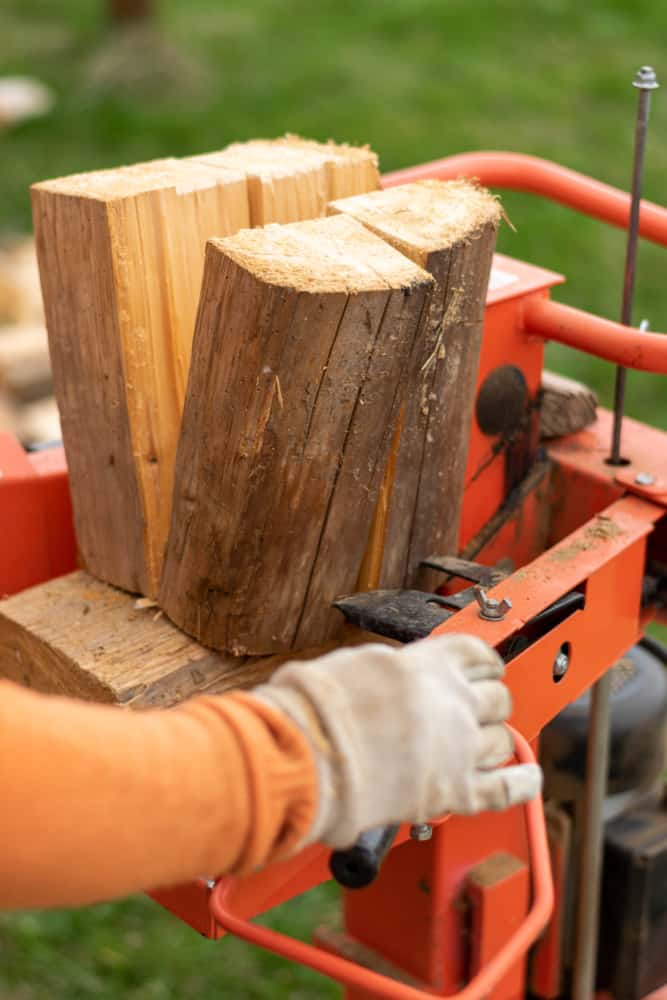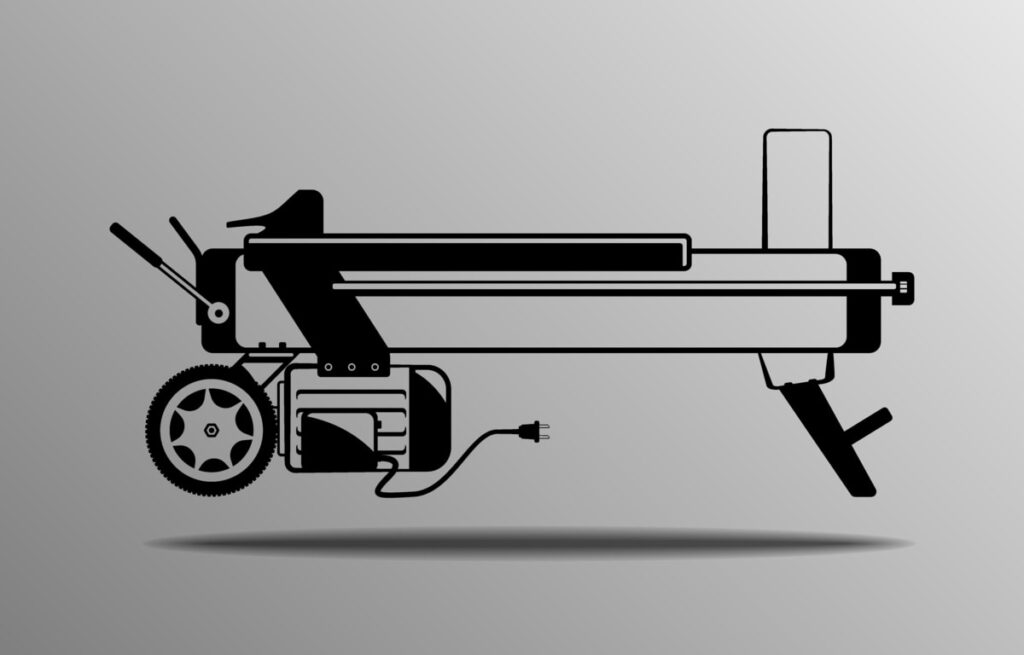To determine the correct size log splitter, consider what you will use it for.
Log splitters are measured by tonnage, with a 30-ton splitter being ideal for larger logs and a 4-ton splitter being sufficient for smaller ones.
Other factors, such as the age and type of wood, should also be considered.
Choosing a new log splitter can be overwhelming due to the numerous variables that must be considered.
When selecting a splitter, you must choose between gas or electric and also ensure that you select the appropriate size for the task at hand.
It is essential to carefully select and review the appropriate log splitter, as choosing a log that is too large may result in damaging the machine.
To find the ideal wood splitter for your needs, we need to consider the variables that will determine the best size for you.

Related Reading: How Often to Change Hydraulic Fluid in Log Splitter?
Table of Contents
Choosing the Best Size Log Splitter
When selecting a log splitter, opting for a smaller size can result in cost savings. Additionally, moving a smaller splitter is generally more manageable than relocating a large one.
Saving money can be achieved by creating a hydraulic log splitter through various DIY options available. However, it requires a certain level of mechanical and technical knowledge.
If you want to save money and avoid making a wrong investment, it’s essential to consider five important factors that will help you determine the right size to choose.
| Size | When splitting logs, it is important to consider the size of the log. For example, if you are splitting a six-inch log that is seasoned, you will need a 4-ton splitter. For 12-inch seasoned logs, a 7-ton splitter is necessary. However, if you are splitting 12-inch green logs, a 16-ton splitter is required. For 24-inch seasoned logs, a 20-ton splitter is needed, while for 24-inch green logs, a splitter that is 30 tons or larger will be necessary. |
| Age of Log | You may have already noticed that the type of log being used is a crucial factor. Seasoned logs tend to have more pores compared to green logs, as they are either old or in the process of dying. On the other hand, green logs are dense and have tougher bark, making them difficult to chop. If you are dealing with green logs, it is recommended to use a large splitter, as mentioned earlier. |
| Wood Density | When deciding on a splitter, it’s important to take into account the type of wood you will be cutting – hardwood or softwood. Hardwood, being dense and tough like greenwood, may require a stronger splitter than a 4-ton one to cut through. Softwood, on the other hand, has loose fibers that make it easier to slice through, and a smaller splitter may be sufficient depending on the size of the wood. |
| Fresh Wood | Cutting fresh wood with a splitter can be challenging due to its high moisture content. This makes it heavier and harder to split. To avoid this, it is recommended to let the wood cure for up to six months before attempting to split it. If you can’t wait, using a larger splitter may be necessary. |
| Type of Wood | Finally, take into account the items you will be splitting. Are you residing in a suburban area with a limited backyard? In that case, you are likely to encounter branches and small logs. Conversely, those who reside in rural areas or near forests may require a bigger splitter to cut firewood and clear passages. |
Questions to Ask Before You Buy a Log Splitter
Before making a purchase of a log splitter, it would be wise to ask some questions.
Even if you buy a large log splitter, it may not perform the job if you haven’t done proper research.
There are plenty of questions to ask, but here are the main concerns that you should think about before making a decision:
| Are there readily available parts online or in-store? | It is important to have easy access to the necessary parts for repairing your log splitter in case of any issues. Failure to do so could result in the loss of your investment if problems are not addressed promptly. |
| Who made the log splitter? | Brand reliability is crucial. Established brands are more likely to endure over time, ensuring the availability of parts and expert employees to assist you with any queries you may have. |
| How quickly does it cut a piece of wood? | Nobody wants to spend all day waiting for a machine to finish its work. Nowadays, most log splitters can efficiently cut large pieces of wood in less than 20 minutes. |
| Does the log splitter come with a warranty? | It’s important to have a warranty for your purchase, as it can save you money and time if anything goes wrong. Without it, you’ll have to pay out of pocket for any repairs or replacements. Especially when you’re making a big investment, it’s wise to consider purchasing a warranty plan. |
| Do you need a gas splitter or an electric splitter? | There are several notable distinctions between gas and electric log splitters. Gas splitters tend to be louder, pricier, and significantly heavier. However, they also have more power, suitable for commercial projects and frequent usage, and generally have a longer lifespan compared to electric log splitters. |
| What is the horsepower of the log splitter? | As a consumer, it’s easy to think that horsepower is the most important factor when it comes to choosing a product. However, it’s important to remember that a good brand and a reliable warranty are actually more essential. Of course, when it comes to handling large logs, a higher horsepower is definitely necessary. |
Additional Thoughts on Choosing the Right Size Log Splitter
Now that you’ve gone through all the questions, factors, and concerns, it’s time to find the log splitter you’ve been searching for.
To select the appropriate wood splitter, you need to identify the type of wood you’re cutting. This includes determining whether it’s hardwood, softwood, green, cured, or seasoned.
Additionally, you’ll need to decide whether you want an electric or gas-powered splitter. Once you have this information, you can choose the right splitter for your needs.
Related Article: Guide: How to Split Logs
For individuals residing in a typical neighborhood with basic wooden branches and small trees, a four to seven-ton splitter would be suitable.
If you frequently have oversized green logs (which is not typical in most neighborhoods), you may want to consider investing in a 16-ton log splitter.
In most cases, anything exceeding that amount is excessive.
However, if you reside in a forested area or near trees that frequently grow, you may consider opting for a slightly larger option in the 16-ton range.
It’s important to take the time to understand the projects you’ll be working on so that you can select the appropriate size log splitter.
If you find that you have excessive power, it could suggest that you could have saved some money at the outset.
On the other hand, if you don’t have enough power, you may have to return the tool and buy a new one to efficiently manage the logs on your property.
As a recommendation for those running a log-cutting business, it is advisable to choose the largest splitter available.

Related Reading: What Is A Kinetic Log Splitter [BETTER THAN HYDRAULIC?]
Conclusion
With log splitters, you can easily get rid of old wood, produce firewood, craft small wooden pieces for your projects, and accomplish so much more.
Using the appropriate splitter for the task guarantees that the process runs seamlessly and prioritizes your safety.
These are some key points to remember from the article:
- Remember to research the brand to determine how long they have been operating.
- You can select either a gas or electric log splitter.
- Splitting Greenwood is generally more difficult compared to splitting properly seasoned wood.
- It is recommended to let your wood cure for a minimum of six months.
- The size of a log splitter is determined based on its tonnage and horsepower.
- It’s not necessary to use the largest splitter to cut wood for your home.
- Before purchasing your first log splitter, it’s important to ask some questions.
- It is important to ensure that your log splitter comes with a warranty. If it does not, consider purchasing one for added protection.
This article aims to assist you in finding the appropriate size of log splitter.
Enjoy living the outdoor life!!!
Related Article: Are Log Splitters Dangerous?
